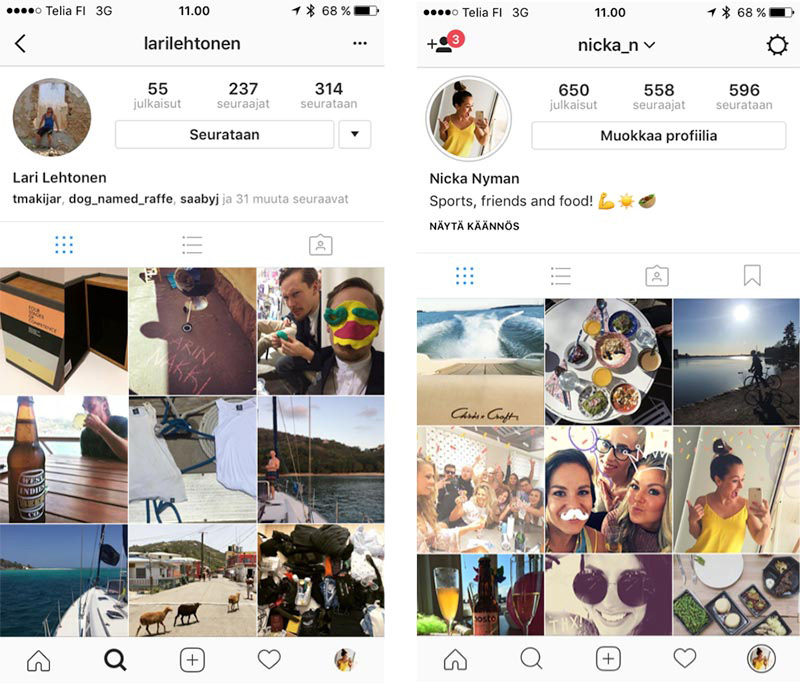Same, same but different – how to reach absolutely everyone in your target demographic (spoiler: it involves Instagram)
The beginning of my Instagram journey started with a classic case of mistaken identity…
In 2014, during the Sotshi Winter Olympics, a professional cross-country skier with whom I share a name, had a bad streak at the men’s relay cross-country event. For him, this spelled a very bad day. For me, this resulted in numerous mentions on Twitter, as disappointed sports fans confused the skier’s Twitter handle with mine. Most were venting their frustration, but the odd person was there to share kind words and encouragement. To tell the truth, this was both an eye-opening and kind of fun day to be me online!
One effect this did have on me was to make me realize that I’d better go and reserve my handle on as many platforms as possible – after all, there was a professional cross-country skier out there who would potentially also be in the market for @larilehtonen! Within minutes, I’d created an Instagram account, not knowing the part it would go on to play in my life (I certainly didn’t envisage writing a blog post about this little photo sharing app at the time).
Two years passed, and apart from a couple of photos posted when I first joined, I hadn’t thought much more about it. But early in 2016, I realized that a good product manager needs to understand their product area inside out, as a user does. Back to Instagram!

A lot had happened in those two years. I had grown a lustrous and much-admired beard, and things had been even more exciting for Instagram. They’d more than doubled in size, from 200 million to 500 million users (it didn’t stop there – they’re now at 700 million!). And in 2015, paid Instagram ads were launched, quickly becoming a key part of Facebook’s advertising portfolio.
To understand how best to target Instagram users, I needed to become an Instagram user. And so, it was with this new advertising element in mind that I returned, to start sharing pictures of my life (see Exhibit A, the time I caught a train).
It’s safe to say, I’m a fairly passive Instagrammer. To date, I’ve shared a total of 55 photos, at a not-very-impressive rate of 1.5 photos posted per month since joining. One thing’s for sure – Instagram hasn’t replaced Facebook as my go-to social network, and I still look at Facebook on my mobile a couple of times a day. If advertisers want to reach me, this is the best place to do it.
In contrast, my colleague Nicka, from Nosto’s marketing team, is quite the opposite. With 650 photos shared, her Insta-post-ratio stands at 12.5 posts per month, and she says she seldom checks Facebook nowadays.
The funny thing is, from a demographic perspective, Nicka and I are surprisingly similar. We both live in central Helsinki, share a couple of interests inside and outside of work topics, shop a lot online and, gosh – how I’ve been waiting to write this – we are both 30-something millennials working in the tech industry. Essentially, on the face of it, demographically we belong to the same target audience for ads (except for gender, obviously. Nicka can’t even dream of growing the kind of beard that I can).
 Spot the difference…
Spot the difference…
The difference is in our mobile app behaviour. Visual inspiration in Instagram is Nicka’s thing, whereas I’m more keen to get my dose of tech-news and puppy videos on Facebook via my mobile. This poses both a problem and a possibility for advertisers:
How does an advertiser go about reaching out to both of us, since according to demographics and interests, we should be in the same group?
Luckily, the answer is simple: target users via both Instagram and Facebook.
If your products are visually compelling, thus fit well on Instagram, it’s absolutely worth adding Instagram to your advertising strategy.
 As you can see, while demographic profiles between customers might look like the same, the way they use different apps and social networks can vary. Since you need to be present wherever your customers are, working with Instagram and Facebook in parallel allows you to be sure that you’re getting in front of both of them. Essentially, Instagram is a tool to extend your campaign’s reach. Your current and future customers are probably users of both networks, but are also likely to have their favorite.
As you can see, while demographic profiles between customers might look like the same, the way they use different apps and social networks can vary. Since you need to be present wherever your customers are, working with Instagram and Facebook in parallel allows you to be sure that you’re getting in front of both of them. Essentially, Instagram is a tool to extend your campaign’s reach. Your current and future customers are probably users of both networks, but are also likely to have their favorite.
Whether you’re like me, and have a semi-professional relationship with Instagram, or Nicka, who is very fond of visual content, you can’t ignore it. It’s likely that a lot of your customers are sharing pictures of their dinner (#omnomnom) on Instagram as we speak!





